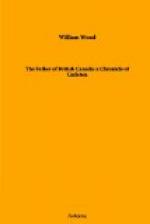In spite of the state of war, however, the French and British officers, even as prisoners and captors, began to make friends. They had found each other foemen worthy of their steel. A distinguished French officer, the Comte de Malartic, writing to Levis, Montcalm’s successor, said: ’I cannot speak too highly of General Murray, although he is our enemy.’ Murray, on his part, was equally loud and generous in his praise of the French. The Canadian seigneurs found fellow-gentlemen among the British officers. The priests and nuns of Quebec found many fellow-Catholics among the Scottish and Irish troops, and nothing but courteous treatment from the soldiers of every rank and form of religion. Murray directed that ‘the compliment of the hat’ should be paid to all religious processions. The Ursuline nuns knitted long stockings for the bare-legged Highlanders when the winter came on, and presented each Scottish officer with an embroidered St Andrew’s Cross on the 30th of November, St Andrew’s Day. The whole garrison won the regard of the town by giving up part of their rations for the hungry poor; while the habitants from the surrounding country presently began to find out that the British were honest to deal with and most humane, though sternly just, as conquerors.
In the following April Levis made his desperate throw for victory; and actually did succeed in defeating Murray outside the walls of Quebec. But the British fleet came up in May; and that summer three British armies converged on Montreal, where the last doomed remnants of French power on the St Lawrence stood despairingly at bay. When Levis found his two thousand effective French regulars surrounded by eight times as many British troops he had no choice but to lay down the arms of France for ever. On the 8th of September 1760 his gallant little army was included in the Capitulation of Montreal, by which the whole of Canada passed into the possession of the British Crown.
Great Britain had a different general idea for each one of the four decades which immediately followed the conquest of Canada. In the sixties the general idea was to kill refractory old French ways with a double dose of new British liberty and kindness, so that Canada might gradually become the loyal fourteenth colony of the Empire in America. But the fates were against this benevolent scheme. The French Canadians were firmly wedded to their old ways of life, except in so far as the new liberty enabled them to throw off irksome duties and restraints, while the new English-speaking ‘colonists’ were so few, and mostly so bad, that they became the cause of endless discord where harmony was essential. In the seventies the idea was to restore the old French-Canadian life so as not only to make Canada proof against the disaffection of the Thirteen Colonies but also to make her a safe base of operations against rebellious Americans. In the eighties the great concern of the government was to make a harmonious whole out of two very widely differing parts—the long-settled French Canadians and the newly arrived United Empire Loyalists. In the nineties each of these parts was set to work out its own salvation under its own provincial constitution.




